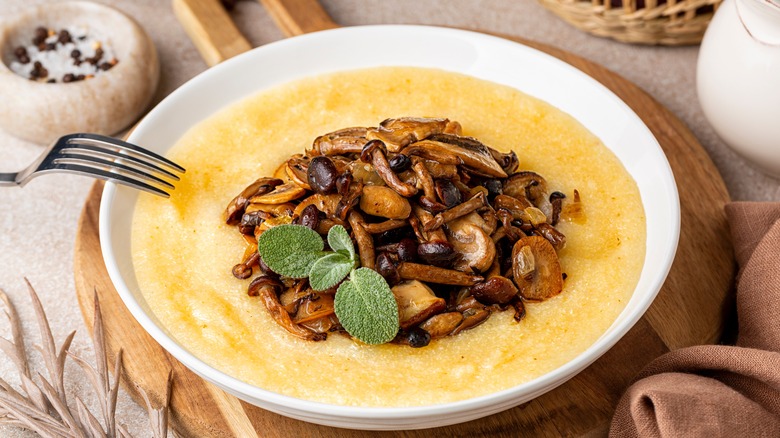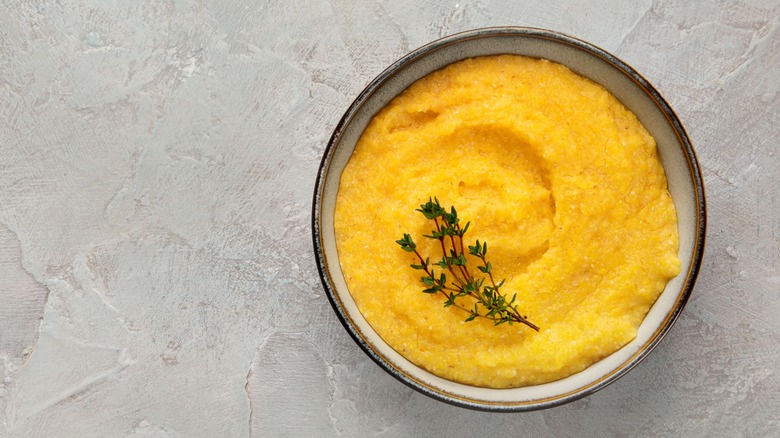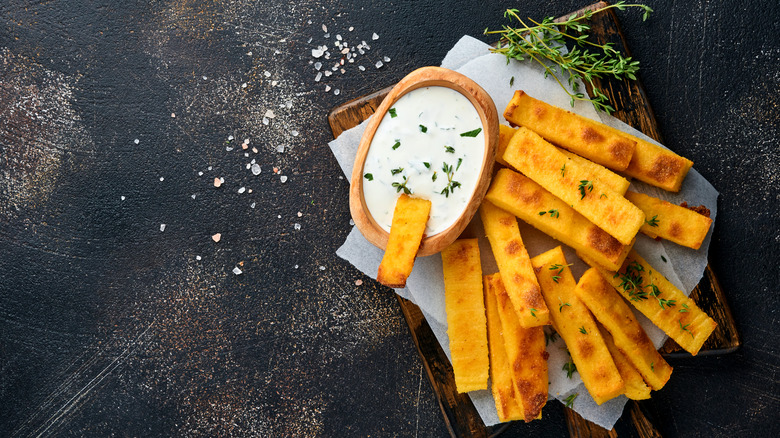Your Oven Is The Secret For Easy, Fast Polenta
Polenta is a creamy, versatile dish that's always comforting and satisfying. It's economical and can stretch into multiple servings, not to mention it makes for great leftovers. However, when preparing polenta, the classic stovetop method can result in unpleasant outcomes – including messy overflow, burnt bottom layers, and general labor intensiveness.
Fortunately, it turns out there's another way to make polenta. Instead of standing by the burner stirring for the entire process, pull open that oven door, and slide in a casserole dish filled with your polenta ingredients. In a short time, you'll have a creamy, flavorful dinner (or breakfast, or dessert) on your hands.
Why is the oven a superior method for polenta? Well, for one thing, it's easy — you'll need only a few minutes of active time to get started before sticking it behind your oven door to do its thing — and easy is hard to argue with. Additionally, the oven allows for more consistency. Instead of a heat source coming from one direction (the bottom of a pot), you have even distribution on all sides, allowing the cornmeal to cook through at the same temperature. This results in a luscious, smooth, and versatile dish that will be hugely satisfying without tons of effort.
The oven-made polenta process
To whip up some oven-made polenta, start by selecting your cornmeal carefully. Because this is essentially a single-ingredient dish, you'll want a quality polenta that's packed with that delicious, defining corn flavor. While you can manage with the instant stuff, it's ideal to reach for the stone-ground, coarse-milled version, as the former tends to get soggy and mushy. Stone-ground cornmeal still contains the germ and hull of the corn, which will yield superior flavor and texture.
Ratios vary a bit per recipe, but will typically be about 4 cups of water (or other liquid) to 1 cup of cornmeal. It does start on the stovetop, by bringing this combination, along with a little salt and pepper, to a simmer and stirring — just as you would start the process otherwise. Once you arrive at that point, that's where you'll pivot, removing the polenta from the heat and transferring it to a casserole or baking dish, then bake until it reaches your preferred creaminess. Polenta can be loose and porridge-like, or firmer and set like a cake.
Once you complete the first round of baking, hit the polenta with some good quality butter, and finish off with a bit more butter, or a grated cheese like Parmigiano-Reggiano or Pecorino Romano. Again, because this dish is composed of so few items, quality matters, so now is a good time to get out that fancy butter or block of cheese.
Polenta possibilities
Polenta is such a fun dish to play with, thanks to its ability to be sweet or savory, creamy or crisp, and served for any meal. As an appetizer or side, you can even cut it into strips and toss them in some hot oil to create polenta fries to pair with your favorite dipping sauce. Alternately, cut pieces of polenta into rounds and top with tomato, mozzarella, basil, and balsamic for caprese polenta sliders. Stay on the veggie train with a polenta and roasted vegetable dish, or go for a warming classic with a buttery, creamy mushroom and polenta.
In the morning, you can treat polenta like oatmeal or porridge and infuse it with sweet flavors of maple and vanilla, or opt for a cheesy casserole made with eggs, breakfast sausage, and leafy greens. And while many polenta-based desserts are simple citrusy cakes, you can also turn your baked polenta into a creamy pudding with your choice of spices like cinnamon, nutmeg, and clove. Once you have the oven polenta method down pat, you can pull out all the stops for your polenta anytime.


